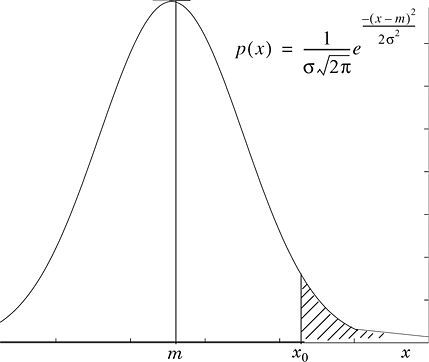Computation of probabilities that involve a Gaussian process require finding the area under the tail of the Gaussian (normal) probability density function as shown in Figure F.1.
Figure F.1 illustrates the probability that a Gaussian random variable x exceeds x0, Pr(x ≥ x0), which is evaluated as
The Gaussian probability density function in Equation (F.1) cannot be integrated in closed form.
Any Gaussian probability density function may be rewritten through use of the substitution
to yield
where the kernel of the integral on the right-hand side of Equation (F.3) is the normalized Gaussian probability density function with mean of 0 and standard deviation of 1. Evaluation of the integral in Equation (F.3) is designated as the Q-function, which is defined as
Hence Equations (F.1) or (F.3) can be evaluated as
The Q-function is bounded by two analytical expressions as follows:
For values of z greater 3.0, both of these bounds closely approximate Q(z).
Two important properties of Q(z) are
A graph of Q(z) versus z is given in Figure F.2.
A tabulation of the Q-function for various values of z is given in Table F.1.
Table F.1. Tabulation of the Q-function
z | Q(z) |
|---|---|
0.0 | 0.50000 |
0.1 | 0.46017 |
0.2 | 0.42074 |
0.3 | 0.38209 |
0.4 | 0.34458 |
0.5 | 0.30854 |
0.6 | 0.27425 |
0.7 | 0.24196 |
0.8 | 0.21186 |
0.9 | 0.18406 |
1.0 | 0.15866 |
1.1 | 0.13567 |
1.2 | 0.11507 |
1.3 | 0.09680 |
1.4 | 0.08076 |
1.5 | 0.06681 |
1.6 | 0.05480 |
1.7 | 0.04457 |
1.8 | 0.03593 |
1.9 | 0.02872 |
2.0 | 0.02275 |
2.1 | 0.01786 |
2.2 | 0.01390 |
2.3 | 0.01072 |
2.4 | 0.00820 |
2.5 | 0.00621 |
2.6 | 0.00466 |
2.7 | 0.00347 |
2.8 | 0.00256 |
2.9 | 0.00187 |
3.0 | 0.00135 |
3.1 | 0.00097 |
3.2 | 0.00069 |
3.3 | 0.00048 |
3.4 | 0.00034 |
3.5 | 0.00023 |
3.6 | 0.00016 |
3.7 | 0.00011 |
3.8 | 0.00007 |
3.9 | 0.00005 |
The error function (erf) is defined as
and the complementary error function (erfc) is defined as
The erfc function is related to the erf function by
The Q-function is related to the erf and erfc functions by
The relationships in Equations (F.11)–(F.13) are widely used in error probability computations. Table F.2 displays values for the erf function.
Table F.2. Tabulation of the Error Function erf(z)
z | erf(z) |
|---|---|
0.1 | 0.11246 |
0.2 | 0.22270 |
0.3 | 0.32863 |
0.4 | 0.42839 |
0.5 | 0.52049 |
0.6 | 0.60385 |
0.7 | 0.67780 |
0.8 | 0.74210 |
0.9 | 0.79691 |
1.0 | 0.84270 |
1.1 | 0.88021 |
1.2 | 0.91031 |
1.3 | 0.93401 |
1.4 | 0.95228 |
1.5 | 0.96611 |
1.6 | 0.97635 |
1.7 | 0.98379 |
1.8 | 0.98909 |
1.9 | 0.99279 |
2.0 | 0.99532 |
2.1 | 0.99702 |
2.2 | 0.99814 |
2.3 | 0.99885 |
2.4 | 0.99931 |
2.5 | 0.99959 |
2.6 | 0.99976 |
2.7 | 0.99987 |
2.8 | 0.99993 |
2.9 | 0.99996 |
3.0 | 0.99998 |








